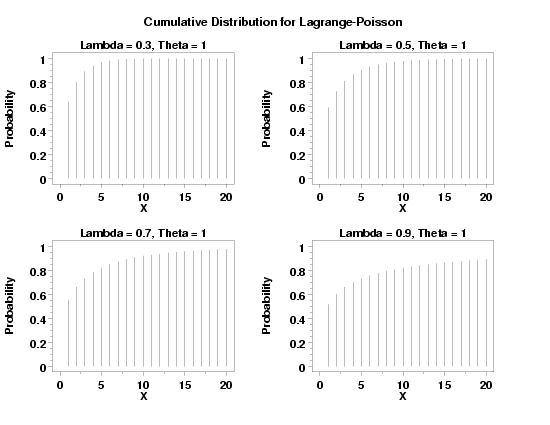

|
LPOCDFName:

with The cumulative distribution function is computed by summing the probability mass function.
<SUBSET/EXCEPT/FOR qualification> where <x> is a positive integer variable, number, or parameter; <lambda> is a number or parameter in the range (0,1) that specifies the first shape parameter; <theta> is a positive number or parameter that specifies the second shape parameter; <y> is a variable or a parameter where the computed Lagrange-Poisson cdf value is stored; and where the <SUBSET/EXCEPT/FOR qualification> is optional.
LET Y = LPOCDF(X1,0.3,2) PLOT LPOCDF(X,0.3,2) FOR X = 0 1 20
P. C. Consul (1989), "Generalized Poisson Distributions", Dekker, New York.
title size 3
tic label size 3
label size 3
legend size 3
height 3
multiplot scale factor 1.5
x1label displacement 12
y1label displacement 17
.
multiplot corner coordinates 0 0 100 95
multiplot scale factor 2
label case asis
title case asis
case asis
tic offset units screen
tic offset 3 3
title displacement 2
y1label Probability
x1label X
.
ylimits 0 1
major ytic mark number 6
minor ytic mark number 3
xlimits 0 20
line blank
spike on
.
multiplot 2 2
.
title Lambda = 0.3, Theta = 1
plot lpocdf(x,0.3,1) for x = 1 1 20
.
title Lambda = 0.5, Theta = 1
plot lpocdf(x,0.5,1) for x = 1 1 20
.
title Lambda = 0.7, Theta = 1
plot lpocdf(x,0.7,1) for x = 1 1 20
.
title Lambda = 0.9, Theta = 1
plot lpocdf(x,0.9,1) for x = 1 1 20
.
end of multiplot
.
justification center
move 50 97
text Cumulative Distribution for Lagrange-Poisson

Date created: 6/20/2006 |